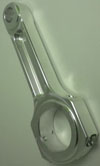Material Choices
 There are several types of materials which are currently used for con rods – some for reasons of manufacturing, some for reasons of quality, but most have been specifically chosen owing to their particular combination of mechanical properties. This month we shall begin to look at con rod materials and, in those cases where they are chosen for reasons of properties alone, what makes each suitable for the particular application.
There are several types of materials which are currently used for con rods – some for reasons of manufacturing, some for reasons of quality, but most have been specifically chosen owing to their particular combination of mechanical properties. This month we shall begin to look at con rod materials and, in those cases where they are chosen for reasons of properties alone, what makes each suitable for the particular application.
In terms of circuit racing, the main types of materials used are steel and titanium but in drag racing, we find that aluminium is widely used, especially for the high-power classes such as top-fuel. We shall begin our ‘tour’ of rod materials by looking at aluminium.
The extremely successful US Army car of Tony Schumacher is equipped with forged aluminium con rods. Aluminium was widely used for automotive con rods in the past, but its use has been almost universally supplanted by steel for production engines. So, what makes aluminium a good choice for a drag-racing con rod, especially given the huge forces involved? Recently, we have canvassed the opinions of a number of con rod manufacturers for a forthcoming article in the magazine, and these included those making aluminium rods for top-fuel.
When we look at the properties of aluminium, we find that, in comparison to steel, that it lacks both strength and stiffness. Furthermore, when we look in greater depth, specifically at the fatigue properties of the materials, we find that aluminium has no defined fatigue limit. In terms of looking at a S-N curve (Wohler diagram), there is no knee in the curve at the high cycle end. Whilst the gradient of the S-N curve is shallow, it is not flat, and this means that, whatever the level of stress-amplitude, an aluminium part will always fail eventually, whereas a steel part will not, providing that the stresses are within certain limits.
The strength of the rod material is not such a concern, as the specific strength (strength divided by density) is not so different from steel materials, so that in respecting the particular level of material strength, the rod should be around the same mass. For those that are involved in the design and analysis of con rods, the nominal stress levels in the shank of the rod are often not very high. So, on the face of it, providing that the rod is properly managed in terms of service life (mileage or time limitations), we could possibly make a lighter rod in aluminium.
However, the main reason given for the selection of aluminium for drag-racing rods is the ability of the material to absorb shock-loads. In this case the rod is acting elastically as a spring, albeit quite a stiff one. It is here that we find that the properties of aluminium are used. Its low modulus of elasticity means that the rod can be designed to have a low stiffness and thus act as a cushion for protecting other parts of the engine (piston and bottom end). Drag-racing can have a lot of detonation in the combustion and the resulting high load spikes can be very damaging to the engine components. So, the rod needs to be designed to an appropriate level of stiffness to suit this. Whilst this can be done in any material, if we were to do this in steel, we would find that the rod has a much smaller cross-sectional area and, more importantly, a lower second moment of area (also known as moment of inertia, area moment of inertia or second moment of inertia), and would therefore be more susceptible to suffer failure due to bucking under abnormal loads.
Written by Wayne Ward.